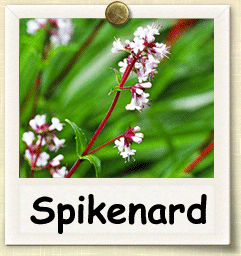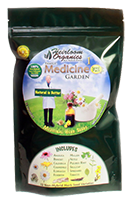|
Home > Guides > Herbs > Spikenard |
|
How to Grow Spikenard | Guide to Growing Spikenard |
|
|
|
|
| |
 |
|
Overview |
|
|
|
|
|
| |
|
| |
Spikenard was a popular herb among American Indians, who gathered its pleasantly scented roots for a variety of medicinal uses. Herbalists record that the Cherokees drank Spikenard tea for backache and that the Shawnees used it to treat gas pains, coughs, asthma, and chest pains. Other tribes gave the tea to women in labor to make childbirth swifter and less painful. The Micmacs reportedly applied a salve of spikenard to cuts and wounds, while the Ojibwas used the root in a poultice for healing broken bones. Early settlers used the juice from the dark purple berries and oil from the seeds. Medical practitioners in the 19th century prescribed the root to treat gout, rheumatism, syphilis, and other diseases in which it was deemed necessary to "purify the blood." More recently, Spikenard has gained popularity as an adaptogen, sharing many common properties with its close relative American Ginseng. |
|
| |
|
|
| |
Growing Guide
GROWING NOTES
Spikenard grows to a height of 5' or more and produces clusters of white flowers that will become deep purple berries in late summer. While the berries are edible, they are a favorite snack of wild turkeys and other wild birds who will deposit the enclosed seeds and propagate new plants.
Spikenard prefers rich, medium-wet to wet soil. It is somewhat tolerant of summer draught, but will do better with consistent moisture.
Spikenard requires some care to germinate successfully. The seeds are small and have naturally low germination rates, but be assisted towards germination with scarification and stratification, which can be initiated in mid to late winter.
Scarification, or gentle abrasion to the seed coat, can simulate the effect the digestive process of consuming animals have upon this seed before it is deposited in the wild. To do this, gently rub a fine-grain sandpaper over the seeds before stratification. Be careful so as not to cause undue damage to the seed-light abrasion is all that is required.
After this, Spikenard requires a cold stratification to prepare the seeds for germination. Carefully mix your seeds with a small amount of light, clean sand. This is to create a light medium that will retain a bit of moisture to keep your seeds damp while providing some protection against fungus. Place mixture into sealed container, and place in refrigerator for approximately 40-60 days, checking regularly to make sure the mixture remains moist and adding water as needed.
MAINTAINING
After around 6 weeks of this cold preparation, your seeds are now ready to be sown, ideally indoors in a greenhouse or warm indoor location. Lightly tamp seeds, or cover with a thin layer of soil (approx ¼" deep). It is ok to leave the sand mixture with your seeds as you sow then as this can help to protect your seeds as they prepare to germinate. With good moisture content and a well-drained medium, it can take as long as 4 weeks or more to germinate so exercise patience and persistence in your attention to your prospective seedlings. Transplant when first true leaves are developed.
|
|
| |
|
| |
Heirloom seeds are the gardeners choice for seed-saving from year-to-year. Learning to save seeds is easy and fun with these books. Before you harvest, consider which varieties you might want to save seeds from so that your harvesting practice includes plants chosen for seed saving. Be sure to check out our newest seed packs, available now from Heirloom Organics. The Super Food Garden is the most nutrient dense garden you can build and everything you need is right here in one pack. The Genesis Garden s a very popular Bible Garden collection. The Three Sisters Garden was the first example of companion planting in Native American culture. See all of our brand-new seed pack offerings in our store.
|
|
| |
|
|
| |
Harvesting Guide
HARVESTING
The root can be harvested in early spring or late fall, but may require several years to produce a sizable rhizome. Additionally, you can leave your plant intact by cultivating only a portion of the rhizome and leaving the bulk still intact. The berries can be harvested in fall, but may be left for birds and other critters who favor them.
SAVING SEEDS
|
|
| |
|
|
|
| |
|
|
|
|
|
| You can find this variety in the following Seed Packs: |
|
 |
|
| Click the packs below to see some of our other wonderful products |
|
|
|
|
|
|
|